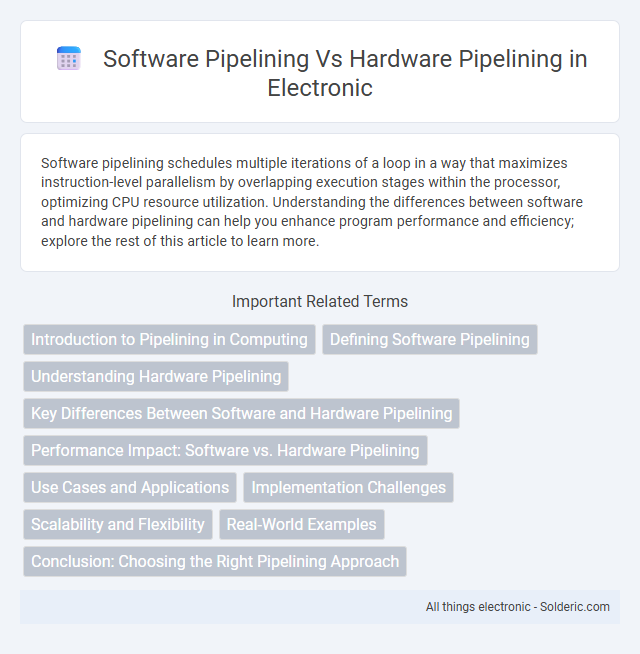Software pipelining schedules multiple iterations of a loop in a way that maximizes instruction-level parallelism by overlapping execution stages within the processor, optimizing CPU resource utilization. Understanding the differences between software and hardware pipelining can help you enhance program performance and efficiency; explore the rest of this article to learn more.
Comparison Table
| Aspect | Software Pipelining | Hardware Pipelining |
|---|---|---|
| Definition | Compiler-driven scheduling technique for overlapping instructions in loops. | CPU-level implementation where multiple instruction stages execute concurrently. |
| Main Goal | Optimize instruction-level parallelism via code arrangement. | Increase instruction throughput by dividing execution into pipeline stages. |
| Implementation | Performed by compiler during code optimization. | Built into processor hardware architecture. |
| Focus | Loop iterations and scheduling of instructions. | Instruction execution cycle split into fetch, decode, execute, memory access, write-back. |
| Flexibility | Adaptable to target architecture and compiler heuristics. | Fixed hardware pipeline stages. |
| Performance Benefit | Reduces loop execution time by overlapping iterations. | Improves processor throughput and reduces instruction latency. |
| Complexity | High compiler complexity for accurate scheduling and hazard avoidance. | Hardware complexity in pipeline design and hazard handling. |
| Examples | VLIW and EPIC architectures with compiler optimization. | RISC processors (e.g., MIPS, ARM) with hardware pipelines. |
Introduction to Pipelining in Computing
Pipelining in computing enhances processing efficiency by overlapping multiple instruction phases, enabling continuous data flow. Software pipelining rearranges instructions at the compiler level to optimize execution order, improving parallelism within loops. Hardware pipelining physically segments processor tasks into stages, allowing simultaneous instruction processing to increase throughput and reduce latency.
Defining Software Pipelining
Software pipelining is an advanced loop optimization technique that reorders instructions to initiate new iterations before previous ones complete, maximizing instruction-level parallelism and improving CPU pipeline utilization. Unlike hardware pipelining, which is implemented at the processor level to overlap instruction execution stages, software pipelining operates at the compiler level to schedule instructions efficiently. This method reduces stalls and increases throughput by strategically overlapping loop operations within a single pipeline cycle.
Understanding Hardware Pipelining
Hardware pipelining improves processor efficiency by dividing instruction execution into multiple stages, allowing overlapping execution of instructions to increase throughput. Each pipeline stage handles a specific part of the instruction cycle, such as fetch, decode, execute, memory access, and write-back, enabling continuous instruction flow. This technique reduces idle CPU time and maximizes resource utilization, making it essential in modern CPU architecture for achieving higher instruction per cycle (IPC) rates.
Key Differences Between Software and Hardware Pipelining
Software pipelining schedules overlapping instruction execution in compilers to improve CPU throughput without modifying hardware, whereas hardware pipelining physically divides instruction execution into stages for simultaneous processing within the CPU. Software pipelining relies on compiler-level optimizations and instruction reordering, while hardware pipelining demands changes in processor architecture such as pipeline registers and control logic. The key difference lies in software pipelining being a scheduling technique confined to software, and hardware pipelining being an intrinsic processor design feature enabling parallel instruction processing.
Performance Impact: Software vs. Hardware Pipelining
Software pipelining improves performance by rearranging instructions at the compiler level to maximize instruction-level parallelism and minimize stalls, effectively overlapping the execution of successive iterations in a loop. Hardware pipelining enhances performance by physically dividing instruction execution into stages, allowing multiple instructions to be processed simultaneously at different stages, thus increasing instruction throughput. While hardware pipelining offers low-latency and predictable speedups due to parallel stage execution, software pipelining enables optimization across complex instruction sequences, often resulting in better utilization of processor resources under certain workload conditions.
Use Cases and Applications
Software pipelining is commonly used in optimizing loop execution in compilers and high-performance computing applications where instruction-level parallelism is essential. Hardware pipelining is predominantly applied in processor design to improve instruction throughput, enabling faster execution of sequential instructions in CPUs and GPUs. Your choice between these techniques depends on whether you require compiler-level optimization for complex tasks or hardware-level enhancements for core processing speeds.
Implementation Challenges
Software pipelining requires meticulous scheduling of instructions to avoid data hazards and stalls, often demanding complex compiler algorithms and deep analysis of instruction dependencies. Hardware pipelining faces challenges in designing pipeline stages that minimize latency while managing hazards through techniques like forwarding and stalling, increasing circuit complexity and power consumption. Your choice between the two depends on the balance between compiler sophistication and hardware design constraints inherent in each pipelining approach.
Scalability and Flexibility
Software pipelining offers greater flexibility by allowing dynamic scheduling of instructions across multiple loop iterations, enabling better adaptation to varied workloads and easier scalability across different processor architectures. Hardware pipelining provides high throughput through fixed-stage instruction processing but faces scalability limitations due to increased pipeline complexity and hardware constraints as stages multiply. Scalability in software pipelining benefits from compiler optimizations and runtime adjustments, whereas hardware pipelining scalability is restricted by physical design and clock cycle ceilings.
Real-World Examples
Software pipelining enhances CPU instruction throughput by rearranging loops in compilers, as demonstrated in DSP processors used in audio and video encoding where efficient instruction scheduling improves performance. Hardware pipelining is evident in modern CPUs like Intel's Core series, where the processor stages instruction execution to achieve higher clock speeds and parallelism. Your choice between software and hardware pipelining impacts performance optimization strategies depending on whether compiler-level loop optimization or physical CPU architecture manipulation is prioritized.
Conclusion: Choosing the Right Pipelining Approach
Selecting the appropriate pipelining approach depends on the specific application requirements and hardware constraints. Software pipelining optimizes instruction scheduling at the compiler level, improving performance in environments with limited hardware support, while hardware pipelining enhances processor throughput by overlapping instruction execution stages directly within the CPU architecture. Evaluating factors such as system complexity, execution latency, and available resources is crucial to determine whether software or hardware pipelining delivers optimal efficiency.
software pipelining vs hardware pipelining Infographic

 solderic.com
solderic.com